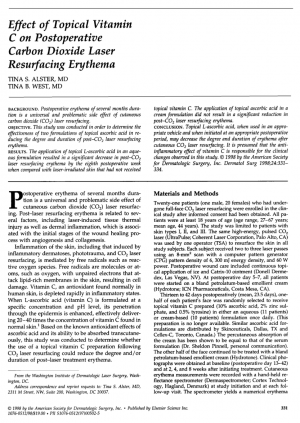The Benefits of Topical Vitamin C (L-Ascorbic Acid) for Skin Care and UV Protection

Abstract
Topical vitamin C formulated at acid pH can be targeted directly into skin to provide pharmacological levels of protection. It becomes a part of the skin, and is unaffected by bathing, exercise, clothing, or make up. The benefits of topical vitamin C (L-Ascorbic Acid) for skin include:
- Protection from UV radiation
- Prevention of UV immunosuppression and DNA mutations
- Reduction of inflammation and erythema associated with sunburn
- Promotion of wound healing
- Stimulation of collagen synthesis
Properly formulated topical vitamin C appears to be a useful complement to sunscreens and other forms of sun protection.
Summary
Vitamin C (L-Ascorbic Acid) neutralizes reactive oxygen species, which is usually stimulated through UV lights, smoking and pollutions. Reactive oxygen species can damage skin constituents including collagen, elastin, proteoglycan, as well as cell membranes and nuclear constituents. Visible signs of this destruction encompass aging such as wrinkles, uneven skin tone, and possibly even skin cancers.
For a topical vitamin C formulation to work maximally, it must be L-Ascorbic Acid, get into skin and then remain stable, and available in a high enough concentration. The gold standard is L-Ascorbic Acid must be at high concentration (greater than 10%) and low pH (less than 3.5).
Vitamin C (L-Ascorbic Acid) is one of the body’s primary protections from reactive oxygen damage, but it is depleted during ultraviolet (UV) injury. Topical vitamin C (L-Ascorbic Acid) therapies provide several benefits for skin. Topical vitamin C protects against UV radiation, including UVA. Topical vitamin C prevents DNA mutations and UV immunosuppression, a reaction that occurs in over 90% of skin cancer patients. Topical vitamin C controls inflammation and reduces erythema. Topical vitamin C promotes wound healing for post aesthetic procedures and stimulates collagen synthesis.
Pinnell, S R., MD and Madey, D L., PhD, 1999. The Benefits of Topical Vitamin C (L-Ascorbic Acid) for Skin Care and UV Protection, Journal of Applied Cosmetology, 18 pp. 126-134.Effect of Topical Vitamin C on Postoperative Carbon Dioxide Laser Resurfacing Erythema

Abstract
Aesthetic procedures such as Carbon Dioxide laser can have problematic side effect such as erythema (redness). This erythema is usually related to several factors, including laser-induced tissue thermal injury as well as dermal inflammation, which is associated with the initial stages of the wound healing process. This study was conducted in order to determine the effectiveness of two formulations of topical ascorbic acid in reducing the degree and duration of post Carbon Dioxide laser resurfacing erythema.
Summary
The study demonstrates that the application of a stable aqueous formulation of 10% L-Ascorbic Acid results in more rapid resolution of erythema (redness) as compared with a bland emollient when topical therapy is initiated 2 or more weeks after the laser resurfacing procedure. There was a significant decrease in the erythema by the 8th week as compared with the side receiving the bland emollient. In addition, the light protection properties of topical vitamin C make it a beneficial addition to conventional sunscreens for short and long term maintenance following Carbon Dioxide laser resurfacing.
Due to the potent antioxidant properties, it is likely that topical vitamin C may play an important role in the prevention and treatment of other cutaneous inflammatory conditions as well.
Alster T S., MD and West T B., MD, 1998. Effect of Topical Vitamin C on Postoperative Carbon Dioxide Laser Resurfacing Erythema, American Society for Dermatologic Surgery, pp. 331-334.

